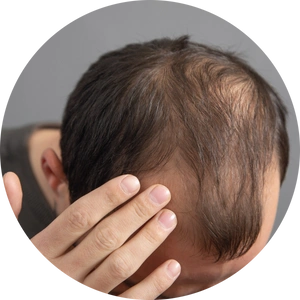If you've started to notice your hairline receding or the hair on the crown of your head slipping away, you may be experiencing male pattern hair loss.
It's a genuine medical condition that affects millions of men globally, and this type of hair loss is actually the most common cause of hair loss among men. Nearly 80% of men will experience significant hair loss in their lifetime because of it.
For most men, the process of losing their hair will start sometimes in their 30s, but it can start later or much earlier depending on genetic traits. In fact, genetics and heredity are key factors in whether you'll be affected by male pattern baldness, also known as androgenic alopecia.
While male pattern hair loss is a progressive condition that results in continual hair loss over time, there are hair loss treatments that can delay loss and even stimulate new growth. The first step to treatment may involve seeing a medical professional.
But which is the best medical professional for hair loss?
The Best Doctor For Hair Loss
If you think you may be experiencing hair loss, the temptation might be to look up the highest-rated dermatologist in your area and make an appointment.
That inclination would be on the right track. Dermatologists are experts regarding both diagnosing and treating hair loss of all varieties, including male pattern hair loss. A dermatologist will help you figure out if your hair loss is merely male pattern hair loss, or if it’s something else entirely. Depending on the cause, hair loss can often be prevented and even reversed in many cases.
What is a Dermatologist?
A dermatologist is a doctor who specializes in conditions that affect the skin, hair, and nails. These medical experts are able to identify and treat the many thousands of conditions affecting these parts of the body, but the most common conditions they treat include eczema, psoriasis, and skin cancer. Because hair emerges from follicles in the skin, hair loss and hair conditions tend to fall under the expertise of these highly trained specialists.
What Type of Training Does a Dermatologist Have?
It takes roughly 12 years of education to become a licensed dermatologist.
Before they can begin practicing, a dermatologist must complete:
- Four years of college to earn a bachelor’s degree
- Four years of medical school to become a medical doctor
- A year-long internship
- Three years of residency, where they work alongside experienced doctors and complete 12,000 to 16,000 hours of patient treatment
What's Required To Become Board Certified?
Once a dermatologist has successfully completed their residency, they have the option of becoming board-certified by completing a challenging exam that will test the knowledge and skills they've acquired over the last decade of education.
Anyone that has their board certification granted by the American Board of Dermatology, the American Osteopathic Board of Dermatology, or the Royal College of Physicians and Surgeons of Canada has received the most rigorous education possible in the field of dermatology.
In other words, there is no other person that will know more about your hair, skin, and nails than a board certified dermatologist.
What About a Trichologist?
If you've looked into possible treatments for hair loss, you may have come across advertisements for trichologists offering to help.
While a trichologist is defined as a hair and scalp specialist, they are more of a bridge between cosmetology and dermatology than their own field. They are generally educated and trained in life sciences and will look at hair loss problems in a holistic way by evaluating their clients' personal history, lifestyle, genetic factors, and environmental conditions.
Depending on the situation, a trichologist may suggest an individualized treatment, give nutritional advice, and recommend lifestyle changes in order to improve the overall health and appearance of the hair and the scalp.
However, this profession is considered to be para-medical in nature, meaning that they assist physicians and doctors and have not received the same level of education themselves. While a trichologist may work with your doctor to figure out a possible treatment for your hair loss, they can not prescribe medications.
How Does A Dermatologist Treat Male Pattern Hair Loss?
Most of the top treatment approaches for male pattern hair loss include a combination of a few different treatments. These are some of the most common individual treatments that a professional may use to help combat hair loss:
Minoxidil
One of the oldest active treatments for male pattern hair loss, minoxidil is better known by its original brand name Rogaine. Today it's available as a generic, and while the exact way that it works isn't perfectly understood, the drug seems to combat hair loss by boosting blood flow to the hair follicle, which can result in a thicker, healthier strand of hair.
Minoxidil is supported by a variety of clinical studies in both men and women, with proven hair regrowth abilities.
Minoxidil is an over-the-counter topical treatment that's designed to be rubbed on the spot where hair loss is occurring daily, sometimes twice daily. Once you start using this product, you may notice a temporary increase in hair loss for the first two to eight weeks. However, this accelerated shedding will stop when your hair begins to regrow. The shedding is a result of hair follicles accelerating through the necessary "telogen" phase, during which active hair growth stops and the follicle lets its prior hair go before beginning growth of a new hair.
A common side effect of minoxidil is a slightly irritated scalp, which may result in dryness, scaling, itching, or redness on your scalp. If this happens beyond a gentle irritation, stop taking minoxidil and consult your clinician.
Since it takes hair so long to grow, it may take some time before you see noticeable results. You will most likely need to use minoxidil continuously for 3 to 6 months before seeing results, and continuous use through 12 months will give you optimal results. Men report seeing continued improvements as far out as two years. Should you ever decide to stop taking minoxidil for whatever reason, your hair gains likely won't stick around: minoxidil requires continual use to maintain thicker hair.
Finasteride
A prescription medication, finasteride is another treatment for male pattern hair loss that's approved by the FDA (one of only two). Finasteride works to decrease the amount of the hormone dihydrotestosterone (DHT) in your body. DHT is the main chemical believed responsible for male pattern hair loss. In those who are genetically susceptible, the DHT that is at your scalp causes your hair follicles to become thinner or weaker, which can eventually prevent them from growing new hair to replace old hair that’s been shed. Finasteride stops the conversion of testosterone into dihydrotesosterone, and it can decrease circulating DHT by as much as 85%.
By decreasing your levels of DHT, it’s possible to slow down and stop the hair loss process, and even stimulate new growth as well. It can take six months to a year of treatment before you will know how effective it can be for you, but studies have shown it's effective in a majority of men.
If you have no hair growth within 12 months, this medication likely won't help you. Just like minoxidil, once you stop taking this drug, you may lose the hair that it helped to grow within three or four months of discontinuing use.
Hair Transplants
Another treatment that has been used to treat hair loss for many years, and under various iterations, is the hair transplant. In the old days, a surgeon would excise and migrate ~5MM diameter hair "plugs" from one location on your body to the area without hair. Because of the size of early transplants, it was fairly evident in most men that procedure had been done. Early plugs simply looked unnatural.
Today, dermatologists have better tools at their disposal and can transplant much smaller sections of hair, typically from the back of the head, which can then be implanted into tiny slits on the affected area of the scalp. Transplants done today are much less noticeable than those from ten or twenty years ago.
Not everyone will be a good candidate for a hair transplant. If the hair on your scalp is sparse and thin all over, you might not have enough healthy hair that can be transplanted. Patients who are completely bald may not be good candidates for a transplant either. Transplants aren't cheap, costing thousands of dollars or more in many cases.
Laser Therapy
The FDA has approved the use of laser combs, helmets, wands, and other devices to treat hair loss at home. These devices, which are available without a prescription, emit a low level of laser light that can help to stimulate new hair growth. Trials have shown benefits with these devices when used regularly, and they also seem to work better in conjunction with other hair loss medications, like minoxidil and finasteride. You will have to continue using your laser device to see continued results.
Platelet Rich Plasma Therapy
Platelet rich plasma therapy will require a blood sample to get started. After you have blood drawn, the fluid will be placed into a centrifuge that will separate the blood into different components. The platelets, which are a type of blood cell, will be treated and injected into the affected area of your scalp. It’s believed that these platelets can help to stimulate new growth.
Although early research is promising for this approach to hair loss treatment, more studies are needed to know whether this is a safe and effective treatment for male pattern baldness.
The Takeaway
If you're experiencing hair loss for any reason, a board-certified dermatologist is likely the best doctor to evaluate your needs.
There is no profession that requires more knowledge about your hair than a dermatologist. While a trichologist will also learn about your scalp and hair, this profession doesn't have the same depth of education, nor can they deploy prescription medications.
Rex MD carries all of the most effective and easy-to-use hair loss medications for men at great prices and prescribed with the help of a licensed clinician online, if appropriate. It's easy and fast, with the most effective FDA-approved medications all on our website.
Learn more about Rex MD and your hair loss options here.
SOURCES
https://www.ncbi.nlm.nih.gov/pmc/articles/PMC7706760/
https://www.niams.nih.gov/labs/dermatology-branch
https://www.ncbi.nlm.nih.gov/pmc/articles/PMC6374694/
https://worldtrichologysociety.org/what-is-trichology/
https://www.ncbi.nlm.nih.gov/books/NBK262/
https://www.ncbi.nlm.nih.gov/pmc/articles/PMC3944668/
https://www.ncbi.nlm.nih.gov/pmc/articles/PMC4174066/
https://www.ncbi.nlm.nih.gov/books/NBK547740/
https://www.ncbi.nlm.nih.gov/pmc/articles/PMC6691938/












